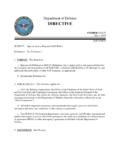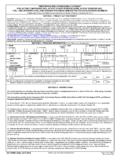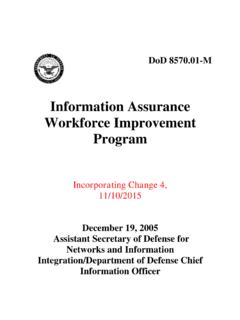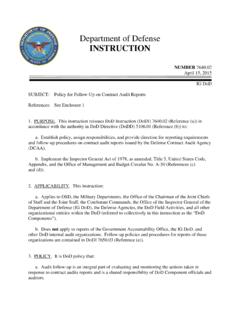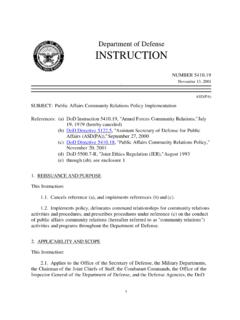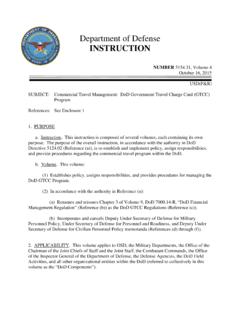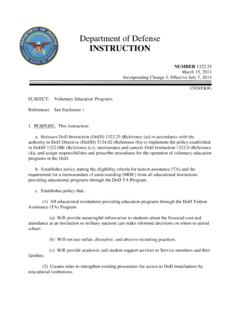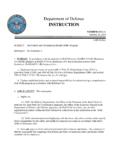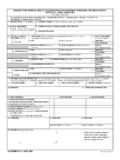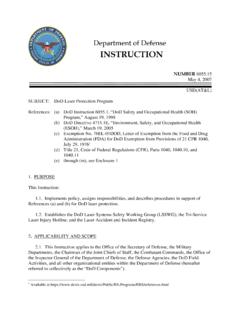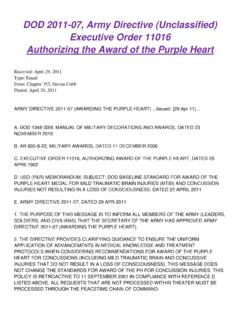Transcription of DoD Directive 8100.02, April 14, 2004; Certified Current ...
1 department of defense Directive NUMBER April 14, 2004 Certified Current as of April 23, 2007 ASD(NII) SUBJECT: Use of Commercial Wireless Devices, Services, and Technologies in the department of defense (DoD) Global Information Grid (GIG) References: (a) DoD Directive , "Global Information Grid (GIG) Overarching Policy," September 19, 2002 (b) Director of Central Intelligence Directive 6/9, "Physical Security Standards for Sensitive Compartmented Information Facilities," November 18, 20021 (c) Director of Central Intelligence Directive 6/3, "Protecting Sensitive Compartmented Information within Information Systems," June 5, 19991 (d) DoD Directive , "Information Assurance (IA)," October 24, 2002 (e) through (m), see enclosure 1 1.
2 PURPOSE This Directive : Establishes policy and assigns responsibilities for the use of commercial wireless devices, services, and technologies in the DoD Global Information Grid (GIG) (reference (a)). Hereafter, the term "wireless" means commercial wireless devices, services, and technologies. Directs the development and use of a Knowledge Management (KM) process to promote the sharing of wireless technology capabilities, vulnerabilities, and vulnerability mitigation strategies throughout the department of defense . Promotes joint interoperability using open standards throughout the department of defense for commercial wireless services, devices, and technological implementations. _____ 1 Limited Distribution. Contact the Office of the Intelligence Community Chief Information Officer.
3 DoDD , April 14, 2004 2 2. APPLICABILITY AND SCOPE This Directive : Applies to the Office of the Secretary of defense , the Military Departments, the Chairman of the Joint Chiefs of Staff, the Combatant Commands, the Office of the Inspector General of the department of defense , the defense Agencies, the DoD Field Activities, and all other organizational entities in the department of defense (hereafter referred to collectively as "the DoD Components"). Applies to all DoD personnel, contractors, and visitors that enter DoD facilities or that have access to DoD information. Applies to all commercial wireless devices, services, and technologies, including voice and data capabilities, that operate either as part of the DoD GIG, or as part of DoD non-GIG Information Technology (IT) (stand-alone) systems.
4 This includes, but is not limited to: commercial wireless networks and Portable Electronic Devices (PED) such as laptop computers with wireless capability, cellular/Personal Communications System (PCS) devices, audio/video recording devices, scanning devices, remote sensors, messaging devices, Personal Digital Assistants (PDA), and any other commercial wireless devices capable of storing, processing, or transmitting information. Does not apply to Information Systems (IS) and/or Sensitive Compartmented Information Facilities (SCIF) to which Director of Central Intelligence Directive (DCID) 6/9 (reference (b)) and DCID 6/3 (reference (c)) apply; , Sensitive Compartmented Information (SCI) and special access programs for intelligence under the purview of the Director of Central Intelligence.
5 Does not apply to receive-only pagers, Global Positioning System receivers, hearing aids, pacemakers, other implanted medical devices, or personal life support systems. The detection segment of a PED ( , the laser used in optical storage media; between a barcode and a scanner head; or Radio Frequency (RF) energy between RF identification tags, both active and passive, and the reader/interrogator) does not require encryption. 3. DEFINITIONS Terms used in this Directive are defined in enclosure 2. 4. POLICY It is DoD policy that: DoDD , April 14, 2004 Wireless devices, services, and technologies that are integrated or connected to DoD networks are considered part of those networks, and must comply with DoD Directive (reference (d)) and DoD Instruction (reference (e)) and be Certified and accredited in accordance with DoD Instruction (reference (f)).
6 In addition: For data, strong authentication, non-repudiation, and personal identification is required for access to a DoD IS in accordance with published DoD policy and procedures. Identification and Authentication (I&A) measures shall be implemented at both the device and network level. I&A of unclassified voice is desirable; voice packets across an Internet protocol ( , Voice over Internet Protocol (VoIP)) shall implement I&A in accordance with published DoD policy and procedures. Encryption of unclassified data for transmission to and from wireless devices is required. Exceptions may be granted on a case-by-case basis as determined by the Designated Approving Authority (DAA) for the wireless connections under their control. At a minimum, data encryption must be implemented end-to-end over an assured channel and shall be validated under the Cryptographic Module Validation Program as meeting requirements per Federal Information Processing Standards (FIPS) Publication (PUB) 140-2, Overall Level 1 or Level 2, as dictated by the sensitivity of the data (reference (g)).
7 Encrypting unclassified voice is desirable; voice packets across an Internet protocol ( , VoIP) shall use encryption that is validated as meeting FIPS 140-2 requirements. For data at rest, PEDs shall use file encryption that is validated as meeting FIPS 140-2 requirements. Individual exceptions may be granted on a case-by-case basis as determined by the DAA. Wireless devices shall not be used for storing, processing, or transmitting classified information without explicit written approval of the cognizant DAA. If approved by the DAA, only assured channels employing National Security Agency (NSA)-approved encryption shall be used to transmit classified information. Classified data stored on PEDs must be encrypted using NSA-approved encryption consistent with storage and treatment of classified information.
8 Measures shall be taken to mitigate denial of service attacks. These measures shall address not only external threats, but potential interference from friendly sources. Introduction of wireless technologies in DoD ISs, including those creating an external interface to non-DoD systems (or allowing use of DoD wireless devices on non-DoD wireless networks) can have a significant adverse effect on the security posture of the IS and requires security review and documentation in accordance with reference (d). DoDD , April 14, 2004 Cellular/PCS and/or other RF or Infrared (IR) wireless devices shall not be allowed into an area where classified information is discussed or processed without written approval from the DAA in consultation with the Cognizant Security Authority (CSA) Certified TEMPEST Technical Authority (CTTA).
9 Wireless technologies/devices used for storing, processing, and/or transmitting information shall not be operated in areas where classified information is electronically stored, processed, or transmitted unless approved by the DAA in consultation with the CSA CTTA. The responsible CTTA shall evaluate the equipment using risk management principles and determine the appropriate minimum separation distances and countermeasures. Pursuant to subparagraph , DAAs shall ensure that Wireless Personal Area Network (WPAN) capability is removed or physically disabled from a device unless FIPS PUB 140-2-validated cryptographic modules are implemented (reference (g)). Exceptions may be granted on a case-by-case basis as determined by the DAA. The DoD Components shall actively screen for wireless devices.
10 Active electromagnetic sensing at the DoD or contractor premises to detect/prevent unauthorized access of DoD ISs shall be periodically performed by the cognizant DAA or defense Security Service office to ensure compliance with the DoD Information Technology Security Certification and Accreditation Process (DITSCAP) ongoing accreditation agreement (reference (f)). Mobile code shall not be downloaded from non-DoD sources. Downloading of mobile code shall only be allowed from trusted DoD sources over assured channels. PEDs that are connected directly to a DoD-wired network ( , via a hot synch connection to a workstation) shall not be permitted to operate wirelessly while directly connected. Anti-virus software shall be used on wireless-capable PEDs and workstations that are used to synchronize/transmit data, in accordance with reference (e).
